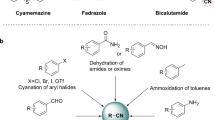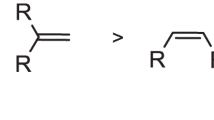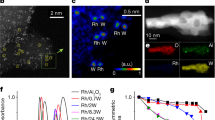Abstract
Selective C–O activation of multifunctional molecules is essential for many important chemical processes. Although reducible metal oxides are active and selective towards reductive C–O bond scission via the reverse Mars–van Krevelen mechanism, the most active oxides undergo bulk reduction during reaction. Here, motivated by the enhanced oxide reducibility by metals, we report a strategy for C–O bond activation by doping the surface of moderately reducible oxides with an ultralow loading of noble metals. We demonstrate the principle using highly dispersed Pt anchored onto TiO2 for furfuryl alcohol conversion to 2-methylfuran. A combination of density functional theory calculations, catalyst characterization (scanning transmission electron microscopy, electron paramagnetic resonance, Fourier-transform infrared spectroscopy and X-ray absorption spectroscopy), kinetic experiments and microkinetic modelling expose substantial C–O activation rate enhancement, without bulk catalyst reduction or unselective ring hydrogenation. A methodology is introduced to quantify various types of sites, revealing that the cationic redox Pt on the TiO2 surface is more active than metallic sites for C–O bond activation.

This is a preview of subscription content, access via your institution
Access options
Access Nature and 54 other Nature Portfolio journals
Get Nature+, our best-value online-access subscription
$29.99 / 30 days
cancel any time
Subscribe to this journal
Receive 12 digital issues and online access to articles
$119.00 per year
only $9.92 per issue
Buy this article
- Purchase on Springer Link
- Instant access to full article PDF
Prices may be subject to local taxes which are calculated during checkout




Similar content being viewed by others
Data availability
The data that support the findings of this paper are available from the corresponding author upon reasonable request. The microkinetic models and the data that support the plots in this paper are available on Mendeley Data59.
Code availability
The code to convert ab initio data to microkinetic model inputs are available on Mendeley Data59.
References
Gallezot, P. & Richard, D. Selective hydrogenation of α,β-unsaturated aldehydes. Catal. Rev. Sci. Eng. 40, 81–126 (1998).
Murillo, L. E., Goda, A. M. & Chen, J. G. Selective hydrogenation of the C=O bond in acrolein through the architecture of bimetallic surface structures. J. Am. Chem. Soc. 129, 7101–7105 (2007).
Su, X. et al. Catalytic carbon dioxide hydrogenation to methane: a review of recent studies. J. Energy Chem. 25, 553–565 (2016).
Mironenko, A. V. & Vlachos, D. G. Conjugation-driven ‘reverse Mars-van Krevelen’-type radical mechanism for low-temperature C-O bond activation. J. Am. Chem. Soc. 138, 8104–8113 (2016).
Luo, J. et al. The H2 pressure dependence of hydrodeoxygenation selectivities for furfural over Pt/C Catalysts. Catal. Lett. 146, 711–717 (2016).
Zacharopoulou, V., Vasiliadou, E. S. & Lemonidou, A. A. Exploring the reaction pathways of bioglycerol hydrodeoxygenation to propene over molybdena-based catalysts. ChemSusChem 11, 264–275 (2018).
Liu, G. et al. MoS2 monolayer catalyst doped with isolated Co atoms for the hydrodeoxygenation reaction. Nat. Chem. 9, 810–816 (2017).
Murugappan, K. et al. Operando NAP-XPS unveils differences in MoO3 and Mo2C during hydrodeoxygenation. Nat. Catal. 1, 960–967 (2018).
Wang, C. et al. Mechanistic study of the direct hydrodeoxygenation of m-cresol over WOx-decorated Pt/C catalysts. ACS Catal. 8, 7749–7759 (2018).
Goulas, K. A., Mironenko, A. V., Jenness, G. R., Mazal, T. & Vlachos, D. G. Fundamentals of C–O bond activation on metal oxide catalysts. Nat. Catal. 2, 269–276 (2019).
Zhang, C., He, H. & Tanaka, K. Catalytic performance and mechanism of a Pt/TiO2 catalyst for the oxidation of formaldehyde at room temperature. Appl. Catal. B 65, 37–43 (2006).
Briggs, N. M. et al. Identification of active sites on supported metal catalysts with carbon nanotube hydrogen highways. Nat. Commun. 9, 3872 (2018).
Boonyasuwat, S., Omotoso, T., Resasco, D. E. & Crossley, S. P. Conversion of guaiacol over supported Ru catalysts. Catal. Lett. 143, 783–791 (2013).
Griffin, M. B. et al. Role of the support and reaction conditions on the vapor-phase deoxygenation of m-cresol over Pt/C and Pt/TiO2 catalysts. ACS Catal. 6, 2715–2727 (2016).
Pham, T. N., Shi, D., Sooknoi, T. & Resasco, D. E. Aqueous-phase ketonization of acetic acid over Ru/TiO2/carbon catalysts. J. Catal. 295, 169–178 (2012).
Pham, T. N., Shi, D. & Resasco, D. E. Kinetics and mechanism of ketonization of acetic acid on Ru/TiO2 catalyst. Top. Catal. 57, 706–714 (2014).
Pacchioni, G. Ketonization of carboxylic acids in biomass conversion over TiO2 and ZrO2 surfaces: a DFT perspective. ACS Catal. 4, 2874–2888 (2014).
Tosoni, S. & Pacchioni, G. Acetic acid ketonization on tetragonal zirconia: role of surface reduction. J. Catal. 344, 465–473 (2016).
Merat, N., Godawa, C. & Gaset, A. High selective production of tetrahydrofurfuryl alcohol: catalytic hydrogenation of furfural and furfuryl alcohol. J. Chem. Technol. Biotechnol. 48, 145–159 (1990).
Iglesia, E. & Boudart, M. Structure-sensitivity and ensemble effects in reactions of strongly adsorbed intermediates. Catalytic dehydrogenation and dehydration of formic acid on nickel. J. Phys. Chem. 95, 7011–7016 (1991).
Liu, L. & Corma, A. Metal catalysts for heterogeneous catalysis: from single atoms to nanoclusters and nanoparticles. Chem. Rev. 118, 4981–5079 (2018).
Qiao, B. et al. Single-atom catalysis of CO oxidation using Pt1/FeOx. Nat. Chem. 3, 634–641 (2011).
Lin, J. et al. Remarkable performance of Ir1/FeOx single-atom catalyst in water gas shift reaction. J. Am. Chem. Soc. 135, 15314–15317 (2013).
Yang, M., Allard, L. F. & Flytzani-Stephanopoulos, M. Atomically dispersed Au-(OH)x species bound on titania catalyze the low-temperature water-gas shift reaction. J. Am. Chem. Soc. 135, 3768–3771 (2013).
Zhang, L., Ren, Y., Liu, W., Wang, A. & Zhang, T. Single-atom catalyst: a rising star for green synthesis of fine chemicals. Natl Sci. Rev. 5, 653–672 (2018).
Sitthisa, S., An, W. & Resasco, D. E. Selective conversion of furfural to methylfuran over silica-supported NiFe bimetallic catalysts. J. Catal. 284, 90–101 (2011).
DeRita, L. et al. Catalyst architecture for stable single atom dispersion enables site-specific spectroscopic and reactivity measurements of CO adsorbed to Pt atoms, oxidized Pt clusters, and metallic Pt clusters on TiO2. J. Am. Chem. Soc. 139, 14150–14165 (2017).
Ding, K. et al. Identification of active sites in CO oxidation and water-gas shift over supported Pt catalysts. Science 350, 189–192 (2015).
Luo, J. et al. Mechanisms for high selectivity in the hydrodeoxygenation of 5-hydroxymethylfurfural over PtCo nanocrystals. ACS Catal. 6, 4095–4104 (2016).
Gilkey, M. J. et al. Mechanistic insights into metal Lewis acid-mediated catalytic transfer hydrogenation of furfural to 2-methylfuran. ACS Catal. 5, 3988–3994 (2015).
Cargnello, M. et al. Control of metal nanocrystal size reveals metal-support interface role for ceria catalysts. Science 341, 771–773 (2013).
Jones, J. et al. Thermally stable single-atom platinum-on-ceria catalysts via atom trapping. Science 353, 150–154 (2016).
Vorotnikov, V., Mpourmpakis, G. & Vlachos, D. G. DFT study of furfural conversion to furan, furfuryl alcohol, and 2-methylfuran on Pd(111). ACS Catal. 2, 2496–2504 (2012).
Zhang, J., Wang, B., Nikolla, E. & Medlin, J. W. Heterogeneous catalysis directing reaction pathways through controlled reactant binding at Pd-TiO2 interfaces. Angew. Chem. 129, 6694–6698 (2017).
DeRita, L. et al. Structural evolution of atomically dispersed Pt catalysts dictates reactivity. Nat. Mater. 18, 746–751 (2019).
Kuo, C.-T., Lu, Y., Kovarik, L., Engelhard, M. & Karim, A. M. Structure sensitivity of acetylene semi-hydrogenation on Pt single atoms and subnanometer clusters. ACS Catal. 9, 11030–11041 (2019).
Kresse, G. & Hafner, J. Ab initio molecular dynamics for liquid metals. Phys. Rev. B 47, 558–561 (1993).
Kresse, G. & Furthmüller, J. Efficient iterative schemes for ab initio total-energy calculations using a plane-wave basis set. Phys. Rev. B 54, 11169–11186 (1996).
Kresse, G. & Furthmüller, J. Efficiency of ab-initio total energy calculations for metals and semiconductors using a plane-wave basis set. Comput. Mater. Sci. 6, 15–50 (1996).
Kresse, G. & Hafner, J. Ab initio molecular-dynamics simulation of the liquid-metal–amorphous-semiconductor transition in germanium. Phys. Rev. B 49, 14251–14269 (1994).
Bahn, S. R. & Jacobsen, K. W. An object-oriented scripting interface to a legacy electronic structure code. Comput. Sci. Eng. 4, 56–66 (2002).
Larsen, A. H. et al. The atomic simulation environment – a python library for working with atoms. J. Phys. Condens. Matter 29, 273002 (2017).
Perdew, J. P., Burke, K. & Ernzerhof, M. Generalized gradient approximation made simple. Phys. Rev. Lett. 77, 3865–3868 (1996).
Kresse, G. & Joubert, D. From ultrasoft pseudopotentials to the projector augmented-wave method. Phys. Rev. B 59, 1758–1775 (1999).
Blöchl, P. E. Projector augmented-wave method. Phys. Rev. B 50, 17953–17979 (1994).
Downs, R. T. & Hall-Wallace, M. The American mineralogist crystal structure database. Am. Mineral. 88, 247–250 (2003).
Islam, M. M., Calatayud, M. & Pacchioni, G. Hydrogen adsorption and diffusion on the anatase TiO2(101) surface: a first-principles investigation. J. Phys. Chem. C 115, 6809–6814 (2011).
Huang, W. F., Raghunath, P. & Lin, M. C. Computational study of the reactions of H2O2 on TiO2 anatase (101) and rutile (110) surfaces. J. Comput. Chem. 32, 1065–1081 (2011).
Esch, T. R., Gadaczek, I. & Bredow, T. Surface structures and thermodynamics of low-index of rutile, brookite and anatase – a comparative DFT study. Appl. Surf. Sci. 288, 275–287 (2014).
Howard, C. J., Sabine, T. M. & Dickson, F. Structural and thermal parameters for rutile and anatase. Acta Crystallogr. B 47, 462–468 (1991).
Grimme, S., Antony, J., Ehrlich, S. & Krieg, H. A consistent and accurate ab initio parametrization of density functional dispersion correction (DFT-D) for the 94 elements H-Pu. J. Chem. Phys. 132, 154104 (2010).
Sheppard, D., Terrell, R. & Henkelman, G. Optimization methods for finding minimum energy paths. J. Chem. Phys. 128, 134106 (2008).
Sheppard, D., Xiao, P., Chemelewski, W., Johnson, D. D. & Henkelman, G. A generalized solid-state nudged elastic band method. J. Chem. Phys. 136, 074103 (2012).
Momma, K. & Izumi, F. VESTA 3 for three-dimentional visualization of crystal, volumetric and morphology data. J. Appl. Crystallogr. 44, 1272–1276 (2011).
Momma, K. & Izumi, F. VESTA: a three-dimensional visualization system for electronic and structural analysis. J. Appl. Crystallogr. 41, 653–658 (2008).
Coltrin, M. E., Kee, R. J. & Rupley, F. M. SURFACE CHEMKIN: A Fortran Package for Analyzing Heterogeneous Chemical Kinetics at a Solid-Surface– Gas-Phase Interface Sandia Report SAND90-2003B 3–91 (Sandia National Laboratories, 1991).
Kee, R. J., Rupley, F. M., Meeks, E. & Miller, J. A. CHEMKIN-III: A Fortran Package for the Analysis of Gas-Phase Chemical and Plasma Kinetics Sandia Report SAND96-8216 3–164 (Sandia National Laboratories, 1996).
Lym, J., Wittreich, G. R. & Vlachos, D. G. A Python Multiscale Thermochemistry Toolbox (pMuTT) for thermochemical and kinetic parameter estimation. Comput. Phys. Commun. 247, 106864 (2019).
Fu, J. et al. Dataset for C–O bond activation using ultra-low loading noble metal catalysts on moderately reducible oxides. Mendeley Data https://doi.org/10.17632/pgmcmfb243.1 (2020).
Acknowledgements
This work was financially supported by the Catalysis Center for Energy Innovation, an Energy Frontier Research Center funded by the US Department of Energy, Office of Science, Office of Basic Energy Sciences under award number DESC0001004. Portions of this work were performed at the DuPont–Northwestern–Dow Collaborative Access Team (DND-CAT) located at Sector 5 of the Advanced Photon Source. DND-CAT is supported by Northwestern University, E.I. DuPont de Nemours and Co., and The Dow Chemical Company. This research used resources of the Advanced Photon Source, a US Department of Energy, Office of Science user facility operated for the Department of Energy, Office of Science by Argonne National Laboratory under contract no. DE-AC02-06CH11357. The research is carried out in part at the Center for Functional Nanomaterials, the 23-ID-2 (IOS) beamline of the National Synchrotron Light Source II at Brookhaven National Laboratory, which is supported by the US Department of Energy, Office of Basic Energy Sciences under contract no. DE-SC0012704 and at the beamline 7-BM (QAS), which is supported by the Synchrotron Catalysis Consortium, US Department of Energy under grant no. DE-SC0012335. We acknowledge the groups of Jingguang Chen, Anatoly Frenkel and Raymond Gorte for valuable discussions, Konstantinos Goulas and Qing Ma for X-ray absorption spectroscopy (XAS) measurements, Sibao Liu for assisting with XPS measurements and Sooyeon Hwang for some of the HAADF-STEM images. We thank Lan Wang for assisting in EPR sample preparation. W.Z. gratefully acknowledges the support of NVIDIA Corporation with the donation of the Titan Xp GPU used for this research.
Author information
Authors and Affiliations
Contributions
J.F. performed experimental kinetic studies, XAS analysis and active site quantification. J.L. carried out DFT calculations and microkinetic modelling. W.Z. performed catalyst synthesis and XPS, IR and TEM analyses. J.A.B. conducted the XPS experiments. N.L. and D.S. carried out the HAADF-STEM analysis. R.T.W. carried out the EPR analysis. A.V.M. and K.A. provided insights into DFT calculations. D.G.V. directed the project and provided guidance for the experimental and theoretical work. The manuscript was written by J.F., J.L., W.Z. and D.G.V. with input from all the authors.
Corresponding author
Ethics declarations
Competing interests
The authors declare no competing interests.
Additional information
Publisher’s note Springer Nature remains neutral with regard to jurisdictional claims in published maps and institutional affiliations.
Supplementary information
Supplementary Information
Supplementary methods, Figs. 1–30, Tables 1–10, Notes 1–7.
Rights and permissions
About this article
Cite this article
Fu, J., Lym, J., Zheng, W. et al. C–O bond activation using ultralow loading of noble metal catalysts on moderately reducible oxides. Nat Catal 3, 446–453 (2020). https://doi.org/10.1038/s41929-020-0445-x
Received:
Accepted:
Published:
Issue Date:
DOI: https://doi.org/10.1038/s41929-020-0445-x
This article is cited by
-
Ultra-low Temperature Catalytic Combustion of Toluene over Pd-Loaded Poplar Wood Monolithic Catalyst
Catalysis Letters (2024)
-
Tuning hydrogenation chemistry of Pd-based heterogeneous catalysts by introducing homogeneous-like ligands
Nature Communications (2023)
-
Tripodal Pd metallenes mediated by Nb2C MXenes for boosting alkynes semihydrogenation
Nature Communications (2023)
-
Highly active, ultra-low loading single-atom iron catalysts for catalytic transfer hydrogenation
Nature Communications (2023)
-
Parts–per–million of ruthenium catalyze the selective chain–walking reaction of terminal alkenes
Nature Communications (2022)



